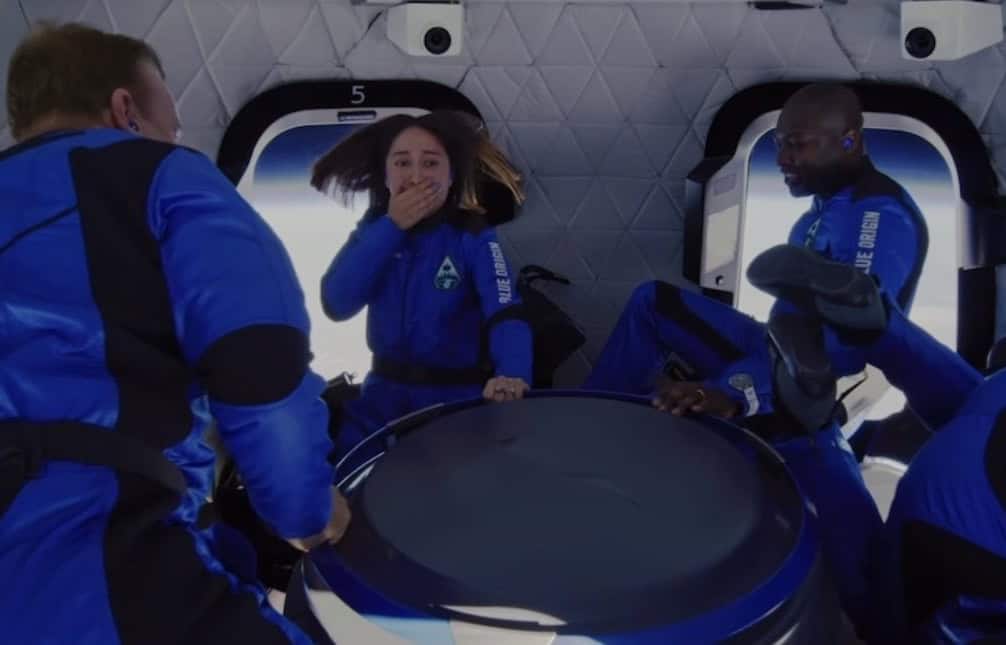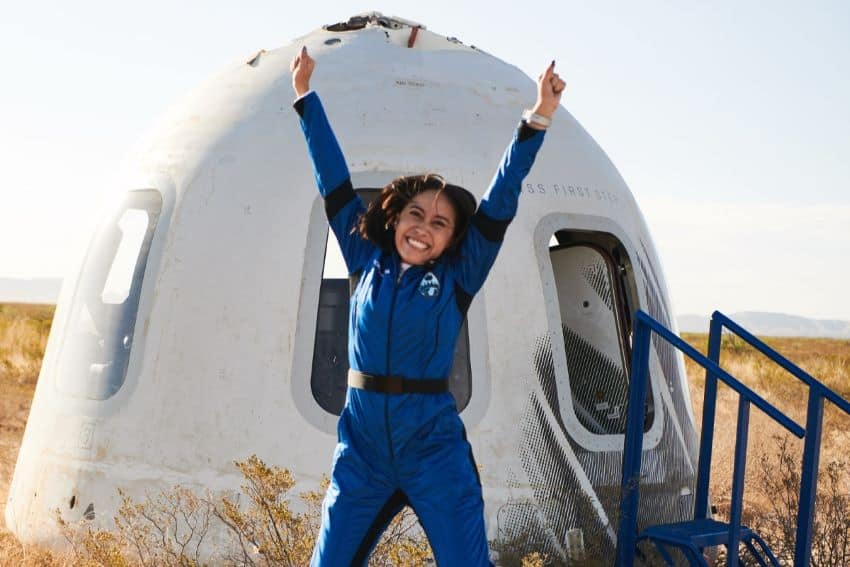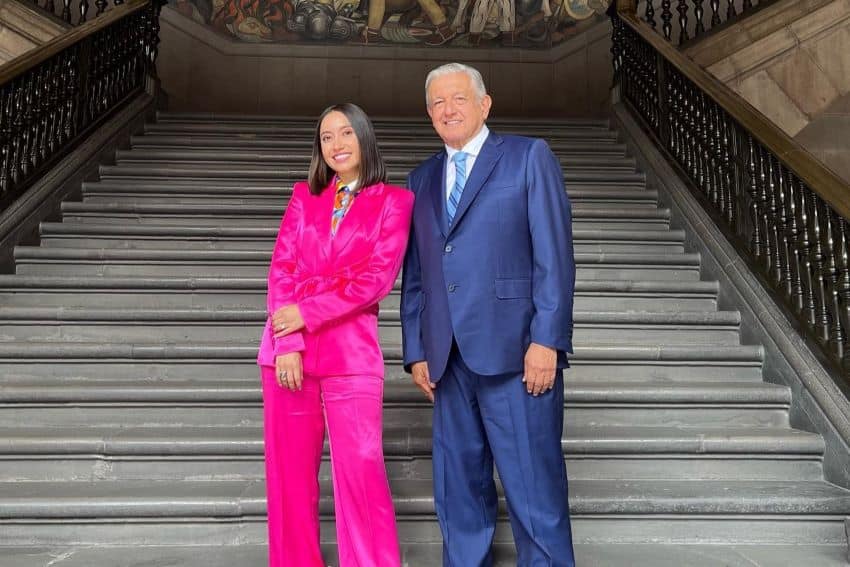At 26, Katya Echazarreta prepared to embark on a great mission: to be the first Mexican woman to travel to space — and the youngest woman to do so. Echazarreta is an electronics engineer and science communicator with an unwavering determination and a deep love for space exploration. Selected as a citizen astronaut by the nonprofit Space for Humanity, she boarded the New Shepard spacecraft on Blue Origin’s NS-21 flight.
Although Echazarreta is small in size compared to the other five crew members on that flight, all of whom were men, her dreams are huge. Now back on earth, she has a new mission: to boost the space industry in Mexico and assemble missions of Mexican astronauts trained in-country.
The first Mexican woman in space

What is the importance of being first? In any field, whether space exploration, science or art, coming first carries significance: opening new frontiers, recognition and prestige and a lasting legacy. For Echazarreta, it symbolizes new possibilities for future generations. When you search the internet for “Latin Americans in space,” she appears alongside Rodolfo Neri Vela, the first Mexican astronaut to go into the cosmos, and José Hernández Moreno, the migrant-born scientist selected by NASA on STS-128.
Echazarreta was born in Mexico and lived here until she was seven when her family decided to move to California. The first few years were complicated, as she had to learn English while starting elementary school. But in sixth grade, she was writing, talking and reading like an eighth grader. From an early age, she was interested in construction tools, Legos and cars; she seemed to love assembling things.
After high school, Echazarreta attended San Diego City College for three years, where she was named Student of the Year in 2016. She was part of the International Society of Women Engineers and served as a mentor for the Mathematics, Engineering and Science Achievement program. She later transferred to the University of California, Los Angeles to complete her degree, the top public institution in the United States according to the U.S. News & World 2024 Best Colleges report.
But it wasn’t all easy. “Getting to UCLA was very difficult. I didn’t have the resources to study. When I was 17 years old, my parents separated. I had been accepted to several universities and I was very excited, but unfortunately, my dad left us. My parents got married in Mexico, so legally, he didn’t owe us anything. From one day to the next, we were left without access to bank accounts, without my mom’s car, and without a house. My only assets were my remaining family — siblings and mother — and a job I had at McDonald’s,” Echazarreta recounted in a lecture titled “Espacio sin Límites” at the National Polytechnic Institute (IPN).

Thanks to two full scholarships, she started her university studies at UCLA. Did everything get better from then on? No. She faced discrimination for being Mexican and a woman, immersed in a scenario full of prejudice and inequality. “When everyone tells you this is not for you, including your professors, you must continue. There was nothing more exciting for me than electronic engineering. Some professors would mention that ‘women had no place in their class’ and would run us out of the classroom,” she recalls in an interview with Newsweek en Español.
Echazarreta finally finished her studies and began a master’s degree in electrical and computer engineering at Johns Hopkins University in Baltimore. Her resume also includes an internship at NASA’s Jet Propulsion Laboratory in Pasadena, where she later became a full-time engineer. She participated in five missions, including the Mars Perseverance Rover and the Europa Clipper voyage to Jupiter.
In addition to this winning streak, Echazarreta is known for her media work, hosting the YouTube series “Netflix IRL” and appearing as Electric Kat on the CBS show “Mission Unstoppable.”
Women, Mexico and STEM careers

Breaking away from Earth’s gravity brought Echazarreta great success. Part of that success was being honored with a doll based on herself in the Barbie Role Models campaign. “Fewer than 80 women have gone into space, and fewer than three dozen have been Black, Indigenous or Latino from a total of 600 people that have ventured into space,” Mattel’s page for the toy says. “Katya is the first Mexican and Latin American-born woman to go.”
Mexico faces the problem of brain and talent drain due to a lack of infrastructure to advantage of peoples’ skills. This causes highly trained students and graduates — such as academics, engineers, doctors and other specialists — to emigrate in search of educational and professional opportunities abroad. This migration of human talent represents a significant loss, as it deprives the country of individuals with valuable skills and knowledge that could contribute to economic, scientific, cultural and social progress.
In 2021, In Mexico, only three out of every ten professionals in science, technology, engineering and mathematics (STEM) careers were women. The problem is social: young girls are not being presented with role models that inspire them to dream of a career in these areas.
Echazarreta is aiming to change that. Last year, she created Mission Mars 2023, the first aerospace camp ever held in Mexico. Here, 100 teenagers between 13 and 15 participated in various tasks at the facilities of Ciudad Creativa Digital and the Lunaria Planetarium in Jalisco. These included robotics, design and programming, habitat and surface research, sustainable crops, as well as simulators and a flight to the red planet.
The Katya Echazarreta Fundación Espacial has announced the second edition of the aerospace camp, scheduled to take place in Mexico City and the state of Morelos. This camp, unique in Mexico and Latin America, aims to train new talents in STEM and aerospace education. The second edition of the Camp will be held July 8-19 and will be free of charge.
Changing the landscape for Mexican astronauts

In a daring move, Echazarreta has given up a promising future at NASA to help open the doors of space for her country. She is advocating for a constitutional reform to prioritize space activities in Mexico. In 2023, the Cámara de Diputados approved a draft decree reforming Articles 28 and 73 of the Mexican Constitution, which regulate activities in outer space. The decree will now pass to the Senate of the Republic, where it will be discussed and submitted to a vote for its possible approval. Among the objectives sought by the “Space Reform” are greater investment in research and technological development in the space field, the possibility of generating strategic alliances with other countries for space projects and the promotion of a culture of innovation and technological development in the country.
Echazarreta’s story has been featured in magazines such as Vogue Mexico, Newsweek en Español and Noir Magazine. Due to her success, the Mexico City borough of Iztapalapa painted a mural of Katya Echazarreta on one of its main avenues, which can be seen from Line 2 of the Cablebus, between the Quetzalcoatl and Xalpa stations. In March 2024, Space for Humanity — the non-profit that sent Echazarreta to space — welcomed three new members to its board of directors: Czech entrepreneur Yemi AD, Australian engineer Chris Boshuizen and Katya Echazarreta.
“Mexicans also dream about going to space,” Echazarreta said in an interview on TikTok, “and that is what I’m working towards: making those dreams reachable.”
Camila Sánchez Bolaño is a journalist, feminist, bookseller, lecturer, and cultural promoter and is Editor in Chief of Newsweek en Español magazine.
